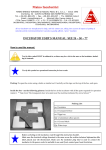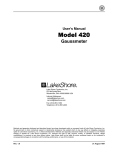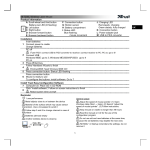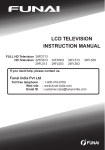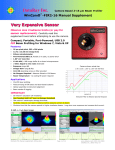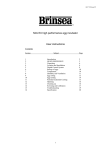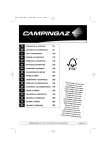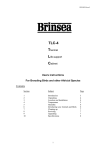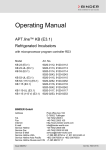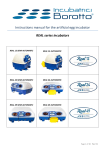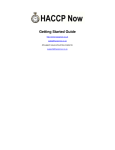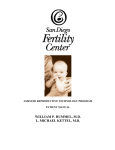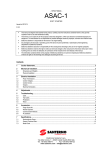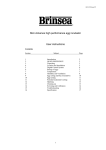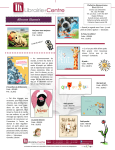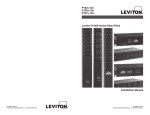Download Maino Incubatrici - Wheatcroft Poultry
Transcript
Maino Incubatrici MAINO ENRICO-ADRIANO di Roberto Maino & C. S.n.c. - Since 1945 Via Roma, 42 - 22070 OLTRONA SAN MAMETTE (CO) Italy Tel. +39-031-891478 ; Fax. +39-031-891457 ; Tlx. 380050 Como I Email: [email protected] - Internet http://www.maino.it CCIA Como 0198979 - C.F. + P.I: IT-01555980133 - C.M. CO-022855 INCUBATRICI; INCUBATORS; BRUTAPPARATE; BROEDMASCHINEN; INCUBATEURS; COUVEUSES; INCUBADORAS All our Incubators are manufactured in Italy, with the utmost care, taking into account all aspects of quality of materials and the environmental factors to produce a quality, effcient, “green” incubator. INCUBATOR USER'S MANUAL: SEE16M and SEE16A How to use this manual. Text by this symbol MUST be adhered to, as there may be a risk to the user or the incubator, including its contents. Text by this symbol are operational instruction for best results. Packing: To open the carton using a knife or similar tool. Carefully cut the tape on the top of the box, and open. Inside the box - see the following pictures: Inside the box is the incubator with all the parts required for operation inside it. ** Take Care! The transparent door is located near the machine (indicated by arrow below) ** Packing List: no.1 Incubator no.1 Transparent Door no.1 Eggs tray (SEE16A Only) Qty of aluminium alloy spacers (SEE16A Only) no.1 Ground Mesh no.1 Thermometer Qty Water trays Before switching on the incubator, read through this instruction booklet. Make sure the electrical voltage (tension) is the same as on the written technical information (the label placed near the thermostat). Make sure the incubator plug that is used to connect the incubator to the power socket is suitable to use, and if not, contact your local electrician. 1. Setting Up The Incubator prior to use: 1.1 Protective Plastic Film—Remove the protective film from all parts of the incubator for best vision into the incubator 1.2 Egg Tray (SEE16A Only)- Set the space required inbetween turning bars on the egg turning tray so as to ensure the eggs sit horizontally through the bars touching the Ground Mesh Important! (SEE16A Only)- Eggs should not sit on the egg bars, the eggs must contact with the Ground Mesh. Otherwise it could break the turning motor and also because, if the egg does not touch the Ground Mesh, egg turning will not happen and then, after the incubation period, nothing will hatch! Example of how set the turning bars for different egg sizes 1.3 Water Trays and Ground Mesh - Place the water trays on the base of the incubator. Do Not fill with water at this time. Place the Ground Mesh on top of the water trays with the edging angled up. 1.4 Place the Turning Tray on Top of the Ground Mesh.(SEE16A Only) Once you have adjusted the position of turning bars, insert the tray inside the incubator, taking care to connect the hook lever of the egg tray with the turning screw that moves the turning tray in the top of the incubator (the screw on the hard plastic disk – see above). 1.5 Slide the front door into position. Slide the door down the side guides, all the way to the bottom, to close the incubator. Ensure the water trays and ground mesh have been pushed to the back of the incubator, so the door closes completely. The top of the door should be level with the top of your incubator. REMEMBER! BEFORE OPENING THE INCUBATOR, ALWAYS STOP THE INCUBATOR BY SWITCHING OFF AND PULLING THE PLUG FROM THE ELECTRICAL SOCKET! 1.6 Plug in your incubator and switch on the electrical socket. The fan should start operating and the LED light on the control panel next to the Temperature adjustment stick. 1.7 Thermometer - Remove the thermometer from its protective shipping case, and carefully place vertically in the hole in the top of the incubator. It will only fit into one hole, and does not need to be forced in. 3.0 Allow the incubator to settle. Allow the incubator to reach and maintain temperature for 8 hours minimum. This is to ensure all components are operating correctly. 3.1 Adjusting the temperature. Once the temperature is settled, take a thermometer reading. You can adjust the temperature up or down by turning the little stick near the red LED hole. Only little movements are needed.Clockwise turns up the temperature and anti-clockwise lowers the temperature. Leave the incubator to settle for 30 minutes between adjustments. The Turning Motor (SEE16A) is always on from the time the electric socket is switched on. It is a slow continual movement, taking 4 hours. This also means when you are checking the turning mechanism, you must check a different time each day as the egg tray will be in the same position every 4 hours. To Switch off the incubator, turn off the electric socket at the wall and remove the plug from the socket. The incubator will return to its previous settings when it is plugged back in and switched on. 5.0 Humidity. Hatching Eggs, during Incubation, need to lose about 13-15% of their egg weight in water vapour, so that the Air Sac is the correct size for hatching. Loss of too much or too little water vapour can cause the chick embryos not to hatch. By reading the Relative Humidity (RH%) we know what percentage of the air is water vapour, and whether to add more water or take away some. Through experience you will get to know the best percentage Relative Humidity to run your incubator at for your eggs. Our advice to start you off is to use the settings in the Species Chart To read Relative Humidity you need a Hygrometer Accessory. If you do not wish to use a hygrometer, keep the water pot full throughout the incubation. DO NOT add more water than in the water pot as this can increase the humidity level too high and cause damage to the incubator. ( More can be added if you are using a Hygrometer accessory) Humidity is directly proportional to the surface area of water in an incubator. To increase humidity, add more surface area, (add another container); to decrease humidity, remove surface area. i.e.Cover a container with tape. Increasing the depth of water does not increase humidity, only means that it will last longer at the current humidity IN ALL CASES DO NOT ALLOW YOUR INCUBATOR TO HAVE WATER CONDENSATION IN IT FOR LONG PERIODS OF TIME AS THIS CAN CAUSE IRREPAIRABLE DAMAGE TO COMPONENTS. NEVER SPRAY OR SPRINKLE WATER INSIDE THE INCUBATOR AS THIS CAN CAUSE THE ELEMENT TO FAIL, KILLING ALL YOUR EMBRYOS. If you must spray your eggs, take the tray of eggs out of the incubator and spray away from the incubator, then replace them. 5.1 Humidity Continued… When using a alternative hygrometer, by increasing or decreasing the surface area of water, you can increase or decrease the humidity in your incubator i.e. if the humidity level is too low, fill another tray in the bottom of the incubator with water. 6.0 Selection of Optimum Hatching Eggs. With most eggs, they should be no older than within 8 days from the date they were laid. Each with good weight, size and without defects or cracks. Eggs should be from healthy breeding flocks . Do not incubate eggs collected on the day they were laid. 6.1 Setting the Hatching Eggs. The eggs should be placed horizontally in the egg tray, inbetween the spacers that you've adjusted before to your size of eggs (See Instruction 1.2) 6.2 Remember that eggs should be placed horizontally in the egg turning tray inbetween the spacer bars, not on the spacer bars. Do Not Cover the Air Exchange Hole(s) over the fan on your incubator. All Embryos breathe in Oxygen and excrete Cardon Dioxide (like us), so by covering the air hole you can suffocate your chicks and they may die. 7.0 Egg Candling. Egg candling should be done after 8 and 18 days after insertion of the eggs in the incubator. When candling an egg, you are looking: at the embryo development, and with some candlers you may be able to see life; the air sac size, checking its growing, and that it is not floating; Identify Eggs that do not have an embryo 4.0 Siting your Incubator Basic features of the room in the room where you install the device: The incubator must be placed in a clean, ventilated room, but away from draughts. It must be supported on a solid surface The room temperature must be between 18 – 23 °C. and 15 – 50 % Relative Humidity. Cold Air (Less than 18 °C will lead to uneven air temperature in the incubator, and could cause a reduce in element life. Do not use in greenhouses ( temperature too variable) or bedrooms for humans or animals. Oxygen is needed by chick embryos in the incubator, eggs that breathing then expel carbon dioxide thus reducing the oxygen levels in the air! This is very harmful to both human and animal health. The machine should be placed OUT of contact with any liquids, that could prejudice the incubators operation and/or also become a very dangerous in operation!. Capacities Kind of Eggs\Model Hen | Duck | Black Turkey Pheasant | Bantam Quail | Grey Partridge Red Partridge Goose | Turkey | Peacock SEE16M 20 24 36 32 7 SEE16A 16 20 32 28 6 8.0 The Hatch Period - The LAST 3 DAYS of the whole period of incubation (see Species Chart) the eggs should NOT BE TURNED. Remove the turning tray (SEE16AOnly)3 days before hatching by carefully lifting it off the Ground Mesh and place to one side without having to handle the eggs. Fill up all your humdity trays to increase the humidity, close the door, and leave the incubator alone. Only open the door to refill humidity trays, then leave it again. Once the chicks start hatching, leave them in the incubator. The chicks can live 3 days after they are born, even without eating or drinking and without any kind of problem. The chicks should not drink because they have to absorb the yolk sac completely. If chicks drink, they may not absorb it completely & it may cause many deaths and deformities. 9.0 General Requirements—Siting your Incubator Basic features of the room in the room where you install the device: The incubator must be placed in a clean, ventilated room, but away from draughts. It must be supported on a solid surface The room temperature must be between 18 – 23 °C. and 15 – 50 % Relative Humidity. Cold Air (Less than 18 °C will lead to uneven air temperature in the incubator, and could cause a reduce in element life. Do not use in greenhouses ( temperature too variable) or bedrooms for humans or animals. Oxygen is needed by chick embryos in the incubator, eggs that breathing then expel carbon dioxide thus reducing the oxygen levels in the air! This is very harmful to both human and animal health. The machine should be placed OUT of contact with any liquids, that could prejudice the incubators operation and/or also become a very dangerous in operation!. TECHNICAL SPECIFICATIONS: ELECTRIC INCUBATOR FOR ANY TYPE OF EGG ELECTRICAL FEATURES: 230 Volt AC + 10/-15% @ 50 Hz ± 0.5% Plugs: Schuko plug (CEE) or British plug (2 poles + E # 13A fuse – British Standard: BS 1363A/95) 10.0 Species Chart Species Days of Incubation Temperature °C % Incubation Humidity Move to Hatching Period After: % Hatching Humidity Hen 21 37.7 40/45 18 days 60/70 Duck/Small turkey 28 37.2/37.5 40/45 25 days 60/70 Dumb Duck 35-42 37.2 40/45 31 days 60/70 Goose 28-42 37.2 45/50 25 days 60/70 Pheasant 24 37.7 40/45 21 days 65/85 Giant Turkey 28-30 37.2 40/45 25 days 60/70 Grey and Red Leg Partridge 23-24 37.7 40/45 20 days 60/70 Quail and Pigeon 17 37.7 40/45 15 days 60/70 Incubator Servicing Incubators used for hatching build up a large amount of chick down, dust and general dirt!. After every hatch your incubator should be cleaned down. This prevents a build up of disease and prolongs the life of your incubator components. If you use your incubator as a setter only( i.e. do not hatch in the incubator), then a 3 monthly clean down is advised to prevent a build up of domestic dust on components. S1.0 General Cleaning Don’t forget to remove the thermometer first, and place in a safe location. Remove heavy dirt and dust using a clean paint brush, and/or compressed air from a can or air-line from around the control card, and the element. Do not get the electrical components wet. Wash in water the incubator base, and Egg Grid, allowing to dry out thoroughly before reusing. Disinfect as required using an approved disinfectant. S1.1 Fans S1.1 R000610 Square Black Fan 1.11 Undo the screws holding the fan in the incubator 1.12 Remove the label on the fan to expose rubber stopper / cover that protects the bearing brass 1.13 Using a screwdriver to remove the rubber stopper 1.14 With an oil can, put a few drops of oil on the brass bearing and then close with the rubber stopper. Reassemble into the incubator Spare Parts List Control Board R000510 Fan R000610 Thermometer RMPS0600 Element R00A710 Turning Motor (SEE16A) R000800 Optional Accessories R009010CC Fluorescent 240v Candler RHD300 LCD Hygrometer GUARANTEE and Certificate Of Conformity Before using the incubator, you should read this instruction manual in full. All instructions, without exception, given in this manual are given in good faith, and we or our dealer / distributor, cannot be held responsible for any damage arising from these instructions, however caused. This includes, without restriction, damages, and hypothetical damage refered to in the use of this given instructions, such as: loss of goods, profits and income; loss of biological value; restoration and replacement cost or other similar costs; or any other special, casual or consequential damage. This information has been written very carefully. We have used best available knowledge in drawing it up, incorporating best technologies and best techniques. However its accuracy and its reliability are in no wise and in no case due to the dealer/ distributor. The authorization to make use of this information is strictly reserved for personal use. Every part of the appliance has been tested by the producer before the delivery and consignment date. Therefore the maker's guarantee does not include damages resulting from an incorrect transportation of the appliance. The guarantee does not include damages to the electric supply and electronic parts resulting from an incorrect connection to the electricity circuits or power surges. The guarantee includes any necessary spare parts and manpower to bring back into use in a functional way the appliance due to any breakdowns that might occur during the following 24 months after the initial testing. The guarantee work is done at the Producers company, or their agent, and will not include refunds of the appliance, or refunds of the damages suffered during the manufacture. The repairs will only have to be done by authorized staff. Not complying with this clause will cause the annulment of the guarantee. REFERENCE SET OF RULES: This product complies with the main requisitions of Electromagnetic and Safety Consistency provided by the Regulations: 89/33/CEE of May 3 1989 with subsequent changes (Regulation 92/31/CEE of April 28 1992 and Regulation 93/68/CEE of July 22 1993); 73/23/CEE of February 19 1973 with subsequent changes (Regulation 93/68/CEE of July 22 1993); Since it has been projected in compliance with the directions of the following Harmonized Rules: CEI EN61000-3-2 (1998) + A14 (2000) ref. Harmonic Current Emissions; EN61000-3-3 ref. Voltage Fluctuations; EN55014-1 ref. Conducted Radiodisturbance Emissions; EN55014-1 ref. Click; EN55014-1 ref. Power Disturbace (30/300 Mhz) & Immunity Tests EN55014-2 ref. ESD , CM , FSB , S, VDSI + EN60335 + EN60335-2-71. The compliance with the above-said main requisitions is attested by means of the affixing of the marking CE¹ on the product. The marking CE¹ was introduced in 1995. We attract your attention on the following actions that may compromise the compliance as well as, obviously, the features of the product: 1. Incorrect electric power; 2. Incorrect installation or incorrect or improper or in any case different use as to the directions written on the user's manual given with the product; 2. Change of parts or of original accessories with others not approved by the maker, or changed by non-authorized staff; DECLARATION OF CONFORMITY according to the attachment II, A of DPR 459/96 THE PRODUCER : IT01555980133 DISTRIBUTED IN THE UK BY : Maino UK , "Dovers Orchard Farm", Hoo Lane, Chipping Campden, Glos. GL55 6AZ VAT GB 275 2945 31 Sales:+44 (0)1386 841109 Web: www.wheatcroftpoultry.co.uk Email [email protected] The Appliance INCUBATOR or HATCHING machine Matriculation Number: From 4512 - 07 - 2003 and so on , until new issue DECLARES THAT: Model: SEE16A and SEE16M IS PROJECTED AND REALIZED IN COMPLIANCE WITH THE MAIN REQUISITES OF SAFETY AND HEALTH OF THE D.P.R. 459/ of July 21 1996 - ATTACHMENT I - The adhesive plate with the mark CE¹ sticked on the appliance is integrant part of it; on the plate there is the specific information of the Appliance Directives. The following Harmonized Rules has been used to implement in a correct way the main requisites of Safety and Health of the ATTACHMENT I: CEI EN61000-3-2 (1998) + A14 (2000) ref. Harmonic Current Emissions; EN61000-3-3 ref. Voltage Fluctuations; EN55014-1 ref. Conducted Radiodisturbance Emissions; EN55014-1 ref. Click; EN55014-1 ref. Power Disturbace (30/300 Mhz) & Immunity Tests EN55014-2 ref. ESD , CM , FSB , S, VDSI + EN60335 + EN60335-2-71 Oltrona di San Mamette 01/07/2003, The declarant: Disposal of old special Equipment (Applicable throughout the European Union and other European countries with separate collection programs). The symbol, found on your product or on its packaging, indicates that this product should not be treated as household waste when you wish to dispose of it. Instead, it should be handed over to an applicable collection point for the recycling. By ensuring this product is disposed of correctly, you will help prevent potential negative consequences to the environment and human health, which could otherwise be caused by inappropriate disposal of this product. The recycling of materials will help to conserve natural resources. For more detailed information about the recycling of this product, please contact your local city office, household waste disposal service or the retail store where you purchased this product RAEE ITALY: IT08040000004688 – VALID ONLY IN ITALY






